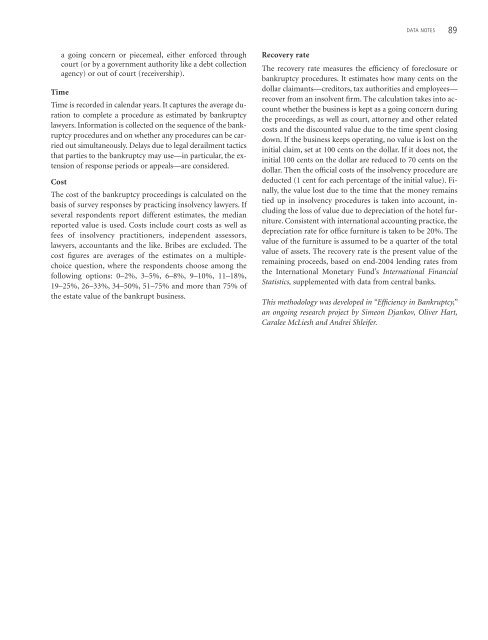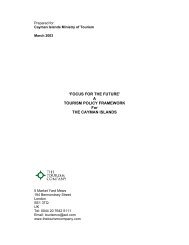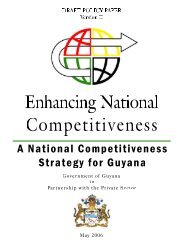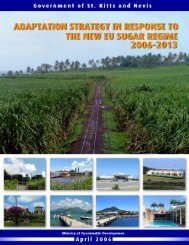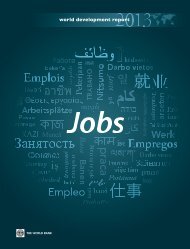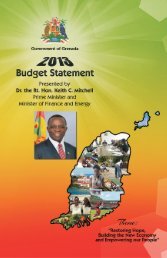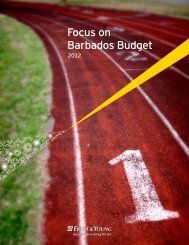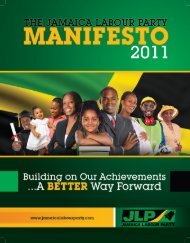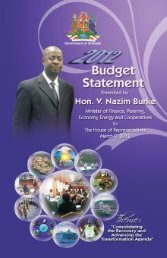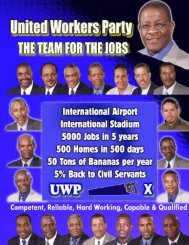Creating
Doing Business in 2006 -- Creating Jobs - Caribbean Elections
Doing Business in 2006 -- Creating Jobs - Caribbean Elections
You also want an ePaper? Increase the reach of your titles
YUMPU automatically turns print PDFs into web optimized ePapers that Google loves.
DATA NOTES 89<br />
a going concern or piecemeal, either enforced through<br />
court (or by a government authority like a debt collection<br />
agency) or out of court (receivership).<br />
Time<br />
Time is recorded in calendar years. It captures the average duration<br />
to complete a procedure as estimated by bankruptcy<br />
lawyers. Information is collected on the sequence of the bankruptcy<br />
procedures and on whether any procedures can be carried<br />
out simultaneously. Delays due to legal derailment tactics<br />
that parties to the bankruptcy may use—in particular, the extension<br />
of response periods or appeals—are considered.<br />
Cost<br />
The cost of the bankruptcy proceedings is calculated on the<br />
basis of survey responses by practicing insolvency lawyers. If<br />
several respondents report different estimates, the median<br />
reported value is used. Costs include court costs as well as<br />
fees of insolvency practitioners, independent assessors,<br />
lawyers, accountants and the like. Bribes are excluded. The<br />
cost figures are averages of the estimates on a multiplechoice<br />
question, where the respondents choose among the<br />
following options: 0–2%, 3–5%, 6–8%, 9–10%, 11–18%,<br />
19–25%, 26–33%, 34–50%, 51–75% and more than 75% of<br />
the estate value of the bankrupt business.<br />
Recovery rate<br />
The recovery rate measures the efficiency of foreclosure or<br />
bankruptcy procedures. It estimates how many cents on the<br />
dollar claimants—creditors, tax authorities and employees—<br />
recover from an insolvent firm. The calculation takes into account<br />
whether the business is kept as a going concern during<br />
the proceedings, as well as court, attorney and other related<br />
costs and the discounted value due to the time spent closing<br />
down. If the business keeps operating, no value is lost on the<br />
initial claim, set at 100 cents on the dollar. If it does not, the<br />
initial 100 cents on the dollar are reduced to 70 cents on the<br />
dollar. Then the official costs of the insolvency procedure are<br />
deducted (1 cent for each percentage of the initial value). Finally,<br />
the value lost due to the time that the money remains<br />
tied up in insolvency procedures is taken into account, including<br />
the loss of value due to depreciation of the hotel furniture.<br />
Consistent with international accounting practice, the<br />
depreciation rate for office furniture is taken to be 20%. The<br />
value of the furniture is assumed to be a quarter of the total<br />
value of assets. The recovery rate is the present value of the<br />
remaining proceeds, based on end-2004 lending rates from<br />
the International Monetary Fund’s International Financial<br />
Statistics, supplemented with data from central banks.<br />
This methodology was developed in “Efficiency in Bankruptcy,”<br />
an ongoing research project by Simeon Djankov, Oliver Hart,<br />
Caralee McLiesh and Andrei Shleifer.


